Louis Jordan's Soundies
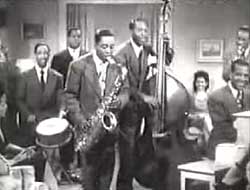 Louis Jordan & His Tympany Band developed a new jive sound much imitated, at the time called Jump Blues, Jumpin' Jive, Jump Jazz, or Shuffle Boogie. When I saw that Caldonia (1945) had been called "the first rock 'n' role film" I had my doubts, but thinking of it as a rock number is certainly intriguing.
Louis Jordan & His Tympany Band developed a new jive sound much imitated, at the time called Jump Blues, Jumpin' Jive, Jump Jazz, or Shuffle Boogie. When I saw that Caldonia (1945) had been called "the first rock 'n' role film" I had my doubts, but thinking of it as a rock number is certainly intriguing.
The roots of rock at least are there in jump boogie, but so too is it in all earlier jitterbug, rhythm & blues, & boogy woogie generally, so I don't think I'd put "first" on it.
"Caldonia" reached #1 on the R&B charts & stayed on top for seven weeks. As a cross-over hit it reached #6 on the national chart. So it's influence on the development of rock would seem to be inescapable.
Caldonia starts in a living room setting, a private party with gals over to hear the band, including beautiful Caldonia (dancer Nicky O'Daniel), Louis Jordan's gal. Louis' basist is pounding out a strong beat & looking blissful. Louis holding his alto sax asks: "Wacha doin', wacha doin', that ain't the piece we's supposed to play!"
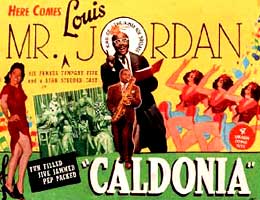 The basist won't stop, so Louis gives up & says, "I guess I better get on in here with it." The basist won't stop, so Louis gives up & says, "I guess I better get on in here with it."
And sure enough, here's the very sort of rock 'n' role sax that would remain standard until the British Invasion eradicated the saxophone as a lead instrument, in favor of electric guitar.
Louis's vocal is great, too, & he simply belongs with the immortals.
The three-minute soundie is an excerpt from a the William Forest Crouch-directed two-reel film of the same title, Caldonia (1945). The full version has a slim story, with Louis' girlfriend Caldonia fooled by a sleeze-bag (Richard Huey) who has convinced her he can make her a star.
It's just an excuse for the tunes, of course, & additional excerpts from the same eighteen-minute film for use as three-minute soundies for jukeboxes were Honey Chile, Buzz Me, & Tillie. The numbers were designed to be shown separately without looking too much like clips, so the two-reel film comes off more as the afterthought than do the four soundies.
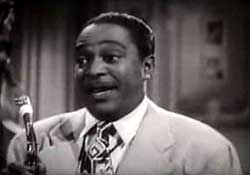 Buzz Me (1945) reached the panoram jukeboxes a year after it had been seen on the big screen as part of a two-reel film. The number starts on a high note from his trumpet player, then the band is going full out jump-jazz blues: Buzz Me (1945) reached the panoram jukeboxes a year after it had been seen on the big screen as part of a two-reel film. The number starts on a high note from his trumpet player, then the band is going full out jump-jazz blues:
"When I saw you this morning, baby, why did you walk away/ When I saw you this morning baby, tell me why did you walk away/ Can't believe that you don't want me/ I thought our love was here to stay."
The scene cuts away to a gal lounging on a wonderfully odd sofa, hovering over a phone as Louis sings on, "Buzz me buzz me buzz me baby, I'll be waitin' for your call/ Buzz me buzz me buzz me baby, I'll be waitin' for your call/ If you forgot the number, come on over you won't have to call at all."
This was a #1 hit on the R&B charts, staying on top for nine weeks, & was a crossover hit on the national chart at #9. Louis had a large number of R&B hits & several were crossovers, for which reason he gained the title "the Jukebox King," which led him naturally enough into soundies.
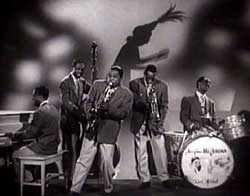 Honey Chile (1945), a soundie excerpted from the same two-reel musical, is a jump-boogie tune about being in love with an ugly woman. Jordan's lyrics run in part: Honey Chile (1945), a soundie excerpted from the same two-reel musical, is a jump-boogie tune about being in love with an ugly woman. Jordan's lyrics run in part:
"I gotta woman nobody loves but me/ But when she starts lovin' me she thrills me to a T/ She got arms like a blacksmith, feet like beam/ The ugliest woman you ever seen/ She don't dress in style/ But she my Honey Chile/ One eye's brown, the other's blue/ She's got false hair & her teeth are too/ But I love to see her smile/ Cuz she's my Honey Chile.
"She's got a wooden leg (yes she has!) all stiff at the knee/ Just like a wooden peg, it's just a limb from the old apple tree/ Her head is flat, her mouth's all numb/ She lost her teeth from chewing gum/ But I love to see her smile/ Cuz she's my Honey Chile."
It's funny but also rather endearing, & it must've given hope to many an ugly gal in love with Jordan's music & therefore with him.
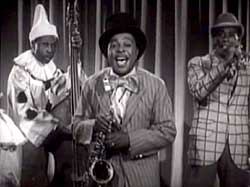 Jordan & his band are on a stage with a shadow-dappled backdrop. As they perform, a woman's silhouette dances on the backdrop, including the dancer's silly hat's shadow. Jordan & his band are on a stage with a shadow-dappled backdrop. As they perform, a woman's silhouette dances on the backdrop, including the dancer's silly hat's shadow.
In Tillie (1945) the Tympany Five are wearing silly outfits, two literally in clown suits. Four gorgeous dancers stand out front. They represent Missie, Jessie, Millie & Tillie of the song's lyrics. One's wearing the odd feathered hat seen in silouhette in Honey Chile.
Jordan in top hat, giant bow-tie, & ridiculous striped pants sings: "M - I - L - L - I - E/ Is sweet as she can be/ But T - I - L - L - I - E/ Is the only one for me."
At the instrumental break while Jordan does his sax solo, a very acrobatic pair of dancers, the guy in tux & tailes, the gal in baton-twirler outfit, do a remarkable routine together. They're billed only as "Taylor & Harris."
"Tillie" is a nice jump-boogie tune doesn't disguise the merely so-so character of the lyrics which not-so-cleverly rhyme Millie with Tillie.
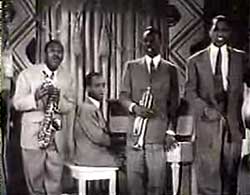 In between some mugging & clowning, Louis sings the great little number Down, Down, Down (1942), harmonizing with his ultra-entertaining band. In between some mugging & clowning, Louis sings the great little number Down, Down, Down (1942), harmonizing with his ultra-entertaining band.
It purports to be sung by the man operating the elevator, reciting as a song what's on each floor, "Lady's cosmetics. Lady's undies," with a couple cuts to gorgeous ladies.
For all it's whimsy, it's also a great jitterbug jazz tune, Louis wailing on his sax once he's through recounting what can be had on each of the floors.
Louis Jordan has been called the first big star of the soundies, whose presence on one of the panorams guaranteed plenty of play & insured cafes & clubs would want to keep the panorams running. Whether "first" really applies is doubtful, but certainly he knew how to take advantage of the panorams to further his reach of his music into America.
There's a little bit of Sachmo in Louis Jordan in that he fprd to the audience, sometimes too much, though there's an elegance about him that places him halfway between anything-to-please Satchmo & the regal dignity of Duke Ellington.
He may just have been a natural born card, or the mugging may in part be an imposition on his performance from days when whites & blacks weren't supposed to mix, & if black entertainers entertained white folks too, they tried not to scare the poor pale bastards.
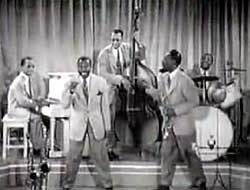 Louis Jordan & His Tympany Band consist of saxophonist & vocalist Louis (Eat Moe), his trumpter-vocalist (No Moe), double-bassist (Four-eyed Moe), pianist (Little Bitty Moe), & drummer (Big Moe) -- five guys total.
Louis Jordan & His Tympany Band consist of saxophonist & vocalist Louis (Eat Moe), his trumpter-vocalist (No Moe), double-bassist (Four-eyed Moe), pianist (Little Bitty Moe), & drummer (Big Moe) -- five guys total.
But often Louis had a slide trumbonist or second sax, so for the wondrous whimsical song Five Guys Named Moe (1942) to always fit the band, Louis couldn't've invariably been one of the Moes.
"Who's the greatest band in town/ Makes the cats jump up & down/ Who's the talk of rhythm town/ Five guys named Moe!"
The three minute soundie provides an absoutely wonderful novelty song that transcends the nature of novelty songs to be honesty a suburb jazz number full of drama, humor, & wild tempo. In 1943 it was #3 on the R&B charts.
Louis usually plays an alto sax but here he's on tenor sax with a brilliant solo, & another solo goes to the trumpet.
The Five Guys Named Moe soundie was spliced together with two other soundies, Fuzzy Wuzzy & Ration Blues, to create the short-subject Louis Jordan Medley (1946). It was also combined with the jukebox soundie Old Man Mose (1942) which briefly features dancer Mabel Lee, & re-released as a theatrical short subject, just for confusion sake, as Old Man Mose (1949).
The reason the two 1942 soundies Five Guys Named Moe & Old Man Mose were made into a 1949 short subject was because Mose is vaguely a sequel to Moe.
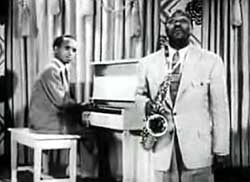 This was a common practice, to take soundies that were distributed individually only in panaoram jukeboxes & splice them into the length of a one-reel short subject to show in movie houses. This was a common practice, to take soundies that were distributed individually only in panaoram jukeboxes & splice them into the length of a one-reel short subject to show in movie houses.
"Ration Blues" was possibly filmed earlier but so far as I can tell was not to have been released as a separate soundie, but was only on the 1946 one-reel Louis Jordan Medley.
The song amusingly complained where complaint mattered: "Baby baby baby, what's wrong with Uncle Sam?/ He's cut down on my sugar, now he's messin' with my ham/ I got the ration blues, blue as I can be/ Oh me, I've got those ration blues."
It was a song Jordan had been singing since the war rationing first began, but he only got round to recording it on disc in 1943, when it went to Number One on the R&B charts & number 11 on the national charts, for his first of several crossover hit, followed with the year by "G. I. Jive" that was number One on both the R&B charts & the mainstream charts.
That both these hits had wartime lyrics reflected the fact that African American soldiers had made certain even white soliders got to know & love Louis Jordan & the Tympany Five.
When the war ended & the restrictions on using materials to press new records were lifted, all those soldiers came home with a new favorite band. The moderate to pretty darned good career Jordan had before the war was transformed by the war years into a powerhouse of a career, & he was selling millions of records.
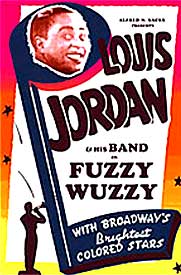 Louis & his band perform the novelty jazz number Fuzzy Wuzzy (1942), a three-minute jukebox soundie which was also part of a ten-minute theatrical release with three other numbers as Louis Jordan Medley (1946), then was used again when spliced into Jordan's theatrical short film also called Fuzzy Wuzzy (1949). Louis & his band perform the novelty jazz number Fuzzy Wuzzy (1942), a three-minute jukebox soundie which was also part of a ten-minute theatrical release with three other numbers as Louis Jordan Medley (1946), then was used again when spliced into Jordan's theatrical short film also called Fuzzy Wuzzy (1949).
The theatrical release co-starred Una Mae Carlisle singing "I Like it Cuz I Love It," Mead "Lux" Lewis with a hot piano rendition of "Low Down Dog," & Maurice Rocco doubling as emcee & performing "Rhumba Boogie."
The set-up is Louis & the band are playing for the jitterbug jamboree, which provides the individual pieces with a better sense of being a single film.
The three-minute soundie Fuzzy Wuzzy includes only the Louis Jordan performance. The lyrics run in part: "There's a gal up Harlem way/ Who's always feeling gay/ She isn't very glamorous/ Neither is she amorous/ But there's one thing you can say/ She's got rhythm. She's got rhythm/ Fuzzy Wuzzy/ Have you met that little hussy."
And for spice, as often in Jordan's soundies, out leaps a gorgeous babe (Ruby Richards) in short-short skirt to dance, dance, dance, because, "She can solid cut a rug/ She's a killer diller jitter bug . . . Step into your evening clothes/ And meet Fuzzy Wuzzy tonight at Joe's!"
Well, I sure wouldn't call any black folks fuzzy wuzzies, but if Louis Jordan wants to, great, just so long as it swings this high.
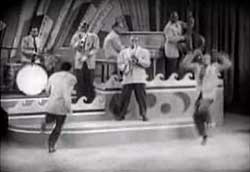 The jukebox soundie, Louis Jordan & his Tympany Band in Jumpin' at the Jubilee (1944), I recognized as taking place in front of the same "leaning city" backdrop used by Harry the Hipster in his soundie Opus 20 EEE (1944).
The jukebox soundie, Louis Jordan & his Tympany Band in Jumpin' at the Jubilee (1944), I recognized as taking place in front of the same "leaning city" backdrop used by Harry the Hipster in his soundie Opus 20 EEE (1944).
The song is not just upbeat but Louis's singing it so fast it's almost like he's speeded up. "Come on baby & follow me/ Let's give them cats somethin' to see/ We'll be as happy as we can be/ When we start jumpin' at the jubilee."
The number had been a sort of theme song for Louis' Armed Forces Radio shows called the Jubilee Show from 1942 to 1944, performances gathered on a CD compilation Jumpin' & Jivin' at the Jubilee, with a lot of other great stuff including "Is You Is Or Is You Ain't My Baby" & equally delightful "Five Guys Named Moe."
Then it's up with his alto sax as in run two do-the-splits tapdancing fellows. They're the Swing Maniacs, who do some jumpin' & flippin' just to fit the lyrics, very acrobatic, & because the song is played so fast, they're like crazed wind-up toys.
Then they run off stage & Louis starts singing again, with an extended drum solo for Eddie Byrd thrown in for closing, the longest drum solo ever in any soundie.
Jordan Jive got recycled into Rocco Blues (1949) with additional soundies & some new footage as a theatrical short. The other material is by the Chantecleers, Maurice Rocco, & the Gingersnaps.
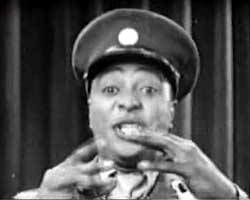 Louis & the band are dressed in their military uniforms to perform G. I. Jive (1944), "It's a G. I. jive/ Man alive/ It starts with a bugler blowing revellee over your bed when you arrive/ Jack, that's the G. I. jive."
Louis & the band are dressed in their military uniforms to perform G. I. Jive (1944), "It's a G. I. jive/ Man alive/ It starts with a bugler blowing revellee over your bed when you arrive/ Jack, that's the G. I. jive."
It's a nice little boogie number written by Johnny Mercer, & was one of Jordan's biggest hits, staying in the charts for more than six months.
But really it isn't one of Louis' absolute best; it's good, but at base it's a commercial number without daring musical stretches, & lyrics taylored for the wartime market.
At the instrumental, while Louis of wailing on his sax, a soldier from one of the cafe tables leaps onto the dance floor to do a slightly whimsical jive dance.
Such images of black soldiers were more important in this era than may now seem possible. The service of African Americans in World War II completely changed the image of blacks for many whites & even for some black folks, who returned from the war unwilling, after risking life or limb, to put up with all the racism, hence a stepped-up Civil Rights movement.
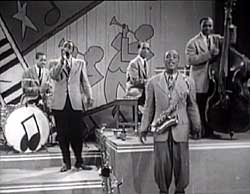 A dancing girl comes out for the instrumental on If You Can't Smile & Say Yes (1944) & does a calesthetics styled routine while Jordan works the sax.
A dancing girl comes out for the instrumental on If You Can't Smile & Say Yes (1944) & does a calesthetics styled routine while Jordan works the sax.
The Tympany Five, numbering four (since sometimes Jordan was the fifth Tympany & sometimes he was the front man for a full five), are behind him, standing against a backdrop decorated with art deco musicians.
The tune's fine written by Louis Jordan & Timmie Rodgers, but the lyrics of this jump-jazz number are a mite clumsy while reflecting the fact that the war is on:
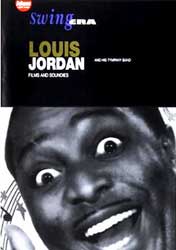 "When I ask you for a date you say no/ You don't know what yo're saying/ Don't you know the war is on/ And everthing is rationed/ How about that jive, keep me alive/ Let bygones be bygones/ Cuz men are scarce as nylons/ If you can't smile & say yes/ Please don't cry & say no." "When I ask you for a date you say no/ You don't know what yo're saying/ Don't you know the war is on/ And everthing is rationed/ How about that jive, keep me alive/ Let bygones be bygones/ Cuz men are scarce as nylons/ If you can't smile & say yes/ Please don't cry & say no."
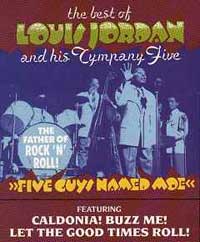 S everal of the Louis Jordan soundies or film clips can be had on one hard-to-find compilation video tape Five Guys Named Moe: The Best of Louis Jordan & His Tympany Band (1991). S everal of the Louis Jordan soundies or film clips can be had on one hard-to-find compilation video tape Five Guys Named Moe: The Best of Louis Jordan & His Tympany Band (1991).
Not originally soundies are the clips from Louis's feature films Beware (1946), Reet, Petite & Gone (1946), & Look Out Sister (1947).
Yet the clips were recycled on panorams as though they were soundies, for the numbers were self-contained within the films, & were either produced or directed by major soundies director William Forest Crouch.
A selection of clips/soundies from these three films can be had on the dvd compilation Swing Era: Louis Jordan & His Tympany Band: Films & Soundies (2003) which is a transfer direct from an older video tape compilation.
copyright © by Paghat the Ratgirl
|
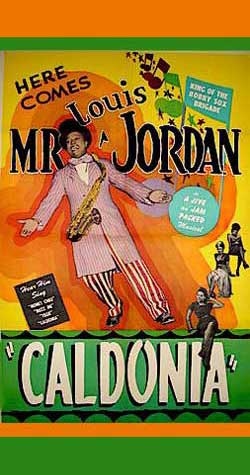

 The basist won't stop, so Louis gives up & says, "I guess I better get on in here with it."
The basist won't stop, so Louis gives up & says, "I guess I better get on in here with it."

 Jordan & his band are on a stage with a shadow-dappled backdrop. As they perform, a woman's silhouette dances on the backdrop, including the dancer's silly hat's shadow.
Jordan & his band are on a stage with a shadow-dappled backdrop. As they perform, a woman's silhouette dances on the backdrop, including the dancer's silly hat's shadow.

 This was a common practice, to take soundies that were distributed individually only in panaoram jukeboxes & splice them into the length of a one-reel short subject to show in movie houses.
This was a common practice, to take soundies that were distributed individually only in panaoram jukeboxes & splice them into the length of a one-reel short subject to show in movie houses.



 "When I ask you for a date you say no/ You don't know what yo're saying/ Don't you know the war is on/ And everthing is rationed/ How about that jive, keep me alive/ Let bygones be bygones/ Cuz men are scarce as nylons/ If you can't smile & say yes/ Please don't cry & say no."
"When I ask you for a date you say no/ You don't know what yo're saying/ Don't you know the war is on/ And everthing is rationed/ How about that jive, keep me alive/ Let bygones be bygones/ Cuz men are scarce as nylons/ If you can't smile & say yes/ Please don't cry & say no."